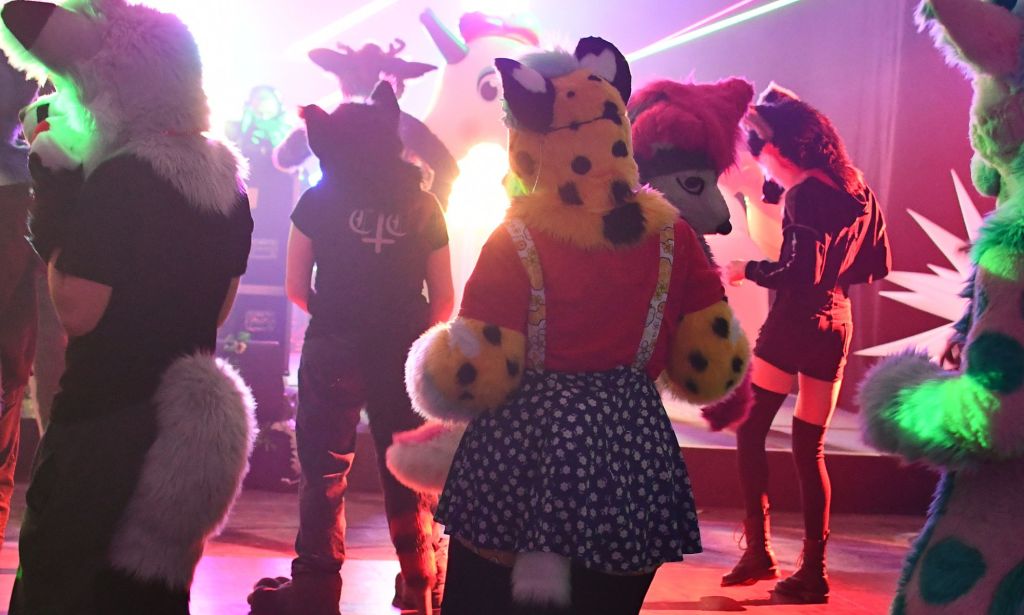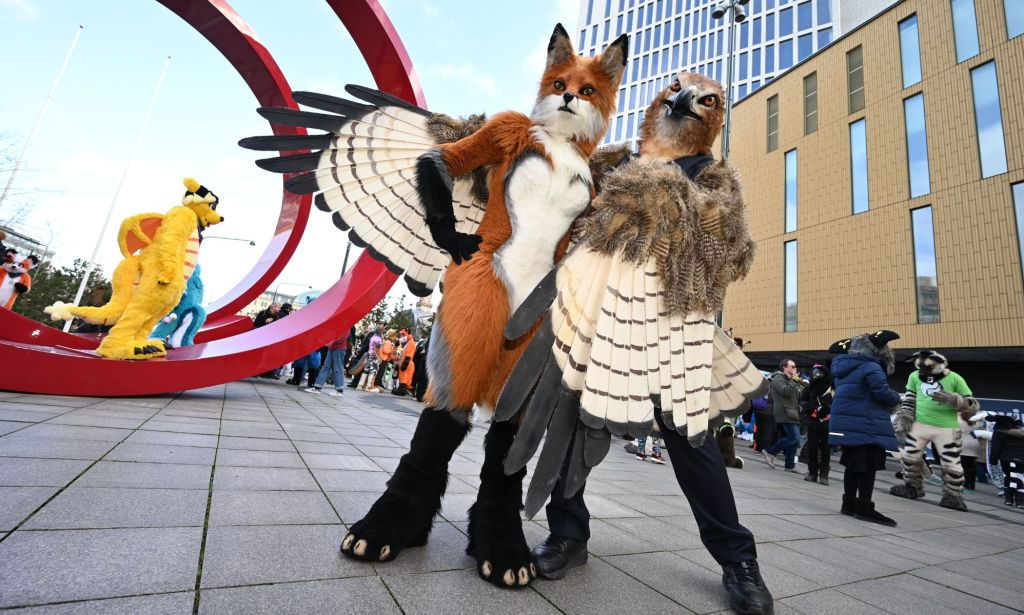LGBTQ+ furries explain everything you ever wanted to know about the subculture, and bust some myths

The furry fandom is filled with LGBTQ+ people who’ve found friendship, joy and creativity. (Getty)
There’s a significant LGBTQ+ presence in the furry community – and for many, it was the furries subculture that helped them understand their queer identity.
The furry subculture comes together to share a love of anthropomorphic animal characters. Many create their own ‘fursonas’ and interact with others in the fandom through these avatars, both in-person through badges or costumes at conventions and online through artistic renditions or forum handles.
Being a furry isn’t a sexuality or gender, but there is an overlap between the LGBTQ+ community and the furry subculture. Some LGBTQ+ furries tell PinkNews that being part of the community is a means by which they can explore their identity – a sphere where they can engage without many of the traditional fears of judgement.
As with practically anything that deviates from the straight, white, cisgender norm, conservatives and anti-LGBTQ+ figures have used furries as part of their ongoing culture war.
Anti-trans activist Graham Linehan has linked furries to paedophilia, while in the US in 2022 a Republican lawmaker was forced to apologise after claiming schools were putting litter boxes in bathrooms for students who were furries.
Another suggested children were ‘identifying as cats’ while pushing an anti-trans schools bill.
What are furries all about?
All of this is nonsense. LGBTQ+ furries say that if there’s one thing to know about their community, it’s that there is a beautiful breadth of creativity and inclusivity that has helped many get to know themselves better.
Reskell, a creator who runs community groups within the fandom, reckons they wouldn’t have found their identity as a transgender, non-binary queer person “nearly as easily” if it wasn’t for the furry subculture.

“I think I would have worked it out eventually, but I don’t think I’d be where I am now if it wasn’t for having a community that is an open and welcoming space for people who are queer,” they tell PinkNews.
“If you’re in a place where you feel safe to explore who you are, you’re gonna figure it out quicker and with less angst along the way.”
Reskell says the furry subculture – which spans a host of spaces including cosplay, art, gaming and photography to name a few – is a “predominantly queer space”. So much so, they say people are “almost expected to be some kind of queer first”, which is a “very different experience to being in the rest of society”.
Research backs this up – Dr Sharon E Roberts, co-founder of the International Anthropomorphic Research Project (IARP), tells PinkNews the group has found there is a “strong presence of LGBTQ+ furries” in the community.
“Depending on the study, we typically find that at least 70 per cent of the fandom identifies as LGBTQ+, and some of our latest studies indicate that about 25 per cent of the fandom identifies as gender diverse,” Roberts says.

She continues: “Overall, the furry fandom creates a safe place for all kinds of people who are connected by their common interest in anthropomorphic media.
“Our research indicates that the history of bullying faced by many furries, which is twice the rate of our comparison groups, may be a driving factor in trying to keep the fandom a safe place where authentic selves are welcomed.”
Mabel, not her real name, discovered the furry community online as a teen after seeing “cool anthro characters on DeviantArt”, an online art community. Soon, she started incorporating them into her creative writing.
Mabel is trans, and says she spent much of her childhood “repressing” her identity. The furry community was the first space she encountered where it was “OK to be trans”.
“I didn’t consider myself part of the LGBTQ+ community in those early days as I hadn’t come to terms with being trans yet, but the community was explicitly friendly to LGBTQ+ folks,” she says.
She didn’t create her fursona, a “nerdy” and “kind” tigress, until a “number of years into the fandom”.

“But when I did, she became my outlet to explore my gender and understand who I am,” Mabel says. “The only other space I could compare the furry community to is a local LGBTQ+ community in terms of how accepting it is and how much it lets you just openly be yourself.”
She loves how the community comes together to champion good causes, and she’s contributed to LGBTQ+ charities and animal charities in the past. But her happiest moments have been “much smaller than that”, involving the friends she’s made along the way.
“We share memes, laugh, and enjoy just chatting to each other,” Mabel says.
“I’ve met some of them in person and getting to hug those friends for the first time is really emotional. These small moments of sharing laughter and happiness with the people close to me are the best moments I’ve had in this community.”

Like Mabel, Kapú discovered the furry subculture through DeviantArt, initially thinking furries were “weirdos”. But he changed his mind after going to a local meet in college, where he “fell in love with it”.
“I met so many like minded people in such a short amount of time, I wasn’t used to being in a group where I immediately felt comfortable,” Kapú says.
He feels like the furries subculture and LGBTQ+ community almost go “hand in hand” because of similar shared experiences across both groups.
“I feel like because queer folk generally were outcast growing up, the idea of joining a group where you can be someone else, or a more confident version of yourself, is quite appealing,” he says.

Yet, there is a lot of misinformation and stigmatisation about the furry subculture. Furries experience stigma due in part because of the visually unique nature of being part of the fandom in combination of incendiary media portrayals about the community.
Kapú wishes more people understood that furries are “adults who are embracing our childhood fun, imagination and letting it grow with us rather than letting it fade away into a distant memory”.
“It’s an outlet for creativity, passion, and a chance to explore aspects of yourself you might never have thought you had,” he says.
“Honestly, I recommend anyone give it a try. You might be surprised by who you meet and make friends with and what you discover about yourself.”
How did this story make you feel?

